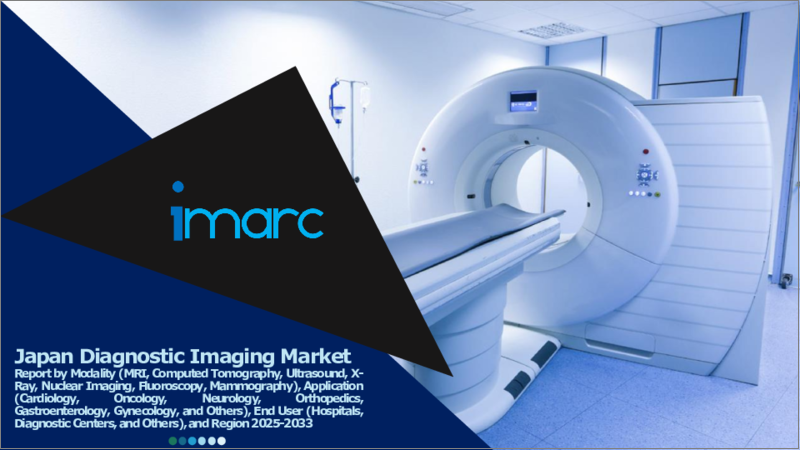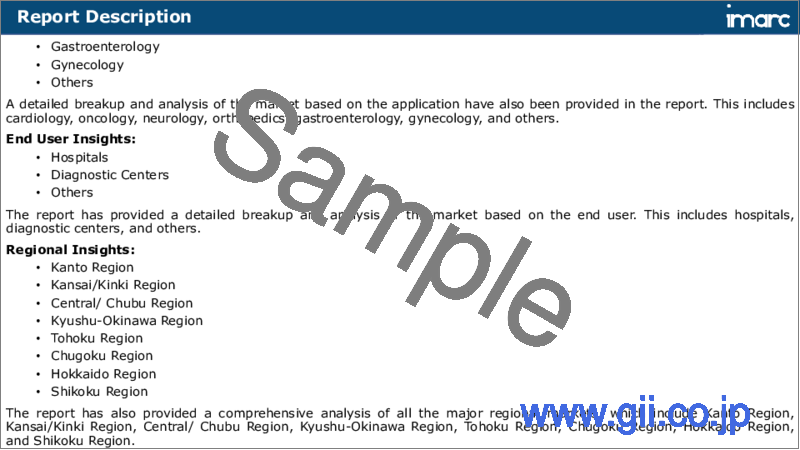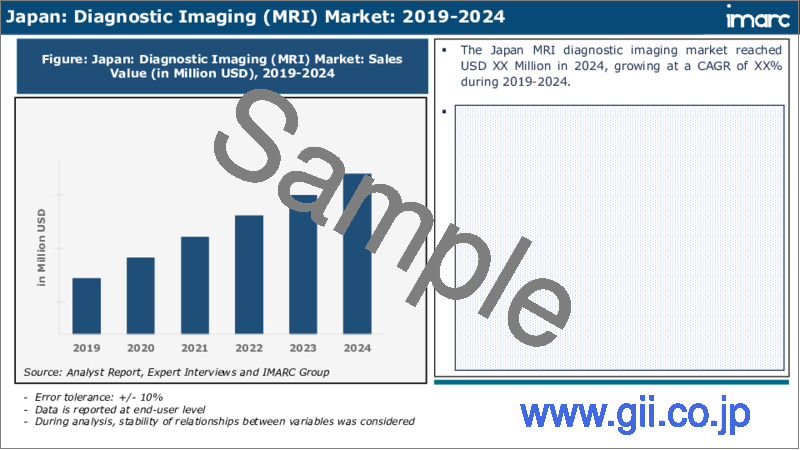|
|
市場調査レポート
商品コード
1609790
日本の画像診断市場レポート:モダリティ、用途、エンドユーザー、地域別、2025年~2033年Japan Diagnostic Imaging Market Report by Modality, Application, End User, and Region 2025-2033 |
||||||
カスタマイズ可能
|
|||||||
| 日本の画像診断市場レポート:モダリティ、用途、エンドユーザー、地域別、2025年~2033年 |
|
出版日: 2024年12月05日
発行: IMARC
ページ情報: 英文 120 Pages
納期: 5~7営業日
|
全表示
- 概要
- 目次
日本の画像診断市場の市場規模は2024年に13億米ドルに達しました。今後、IMARC Groupは、市場は2033年までに21億米ドルに達し、2025~2033年の成長率(CAGR)は5.6%になると予測しています。MRI技術の開発、CTスキャナーの大幅な発展、優れた画像ソリューションを提供するように調整された超音波と核医学の革新が、主に市場成長を牽引しています。
本レポートで扱う主な質問
- 日本の画像診断市場はこれまでどのように推移し、今後どのように推移していくのか?
- COVID-19が日本の画像診断市場に与えた影響は?
- 日本の画像診断市場のモダリティ別の内訳は?
- 日本の画像診断市場の用途別の内訳は?
- 日本の画像診断市場のエンドユーザー別の内訳は?
- 日本の画像診断市場のバリューチェーンにはどのような段階がありますか?
- 日本の画像診断における主な促進要因と課題は?
- 日本の画像診断市場の構造と主要プレーヤーは?
- 日本の画像診断市場における競合の程度は?
目次
第1章 序文
第2章 調査範囲と調査手法
- 調査の目的
- ステークホルダー
- データソース
- 市場推定
- 調査手法
第3章 エグゼクティブサマリー
第4章 日本の画像診断市場-イントロダクション
- 概要
- 市場力学
- 業界動向
- 競合情報
第5章 日本の画像診断市場情勢
- 過去および現在の市場動向(2019年~2024年)
- 市場予測(2025年~2033年)
第6章 日本の画像診断市場- モダリティ別の内訳
- MRI
- コンピュータ断層撮影
- 超音波
- X線
- 核イメージング
- 透視検査
- マンモグラフィー
第7章 日本の画像診断市場- 用途別の内訳
- 心臓病学
- 腫瘍学
- 神経学
- 整形外科
- 消化器内科
- 婦人科
- その他
第8章 日本の画像診断市場- エンドユーザー別の内訳
- 病院
- 診断センター
- その他
第9章 日本の画像診断市場-競合情勢
- 概要
- 市場構造
- 市場プレーヤーのポジショニング
- 主要成功戦略
- 競合ダッシュボード
- 企業評価象限
第10章 主要企業のプロファイル
第11章 日本の画像診断市場- 業界分析
- 促進要因・抑制要因・機会
- ポーターのファイブフォース分析
- バリューチェーン分析
第12章 付録
Japan diagnostic imaging market size reached USD 1.3 Billion in 2024. Looking forward, IMARC Group expects the market to reach USD 2.1 Billion by 2033, exhibiting a growth rate (CAGR) of 5.6% during 2025-2033. Advancements in MRI technologies, significant developments in CT scanners, and innovations in ultrasound and nuclear medicine, tailored to provide superior imaging solutions, are primarily driving the market growth.
Diagnostic imaging stands as a revolutionary pillar in the medical sector, providing a non-invasive method that allows clinicians to see inside the body to assess health conditions and guide treatment strategies. It refers to a variety of techniques that visualize structures and activities in the body, transcending the limitations of a standard physical exam. The spectrum of diagnostic imaging incorporates several modalities such as X-rays, computed tomography (CT) scans, magnetic resonance imaging (MRI), ultrasound, and nuclear medicine, each offering distinct insights into the human body. This innovative field has evolved extensively, powered by advancements in technology, leading to enhanced image quality, reduced radiation exposure, and the development of new imaging modalities. It is crucial in the early detection, diagnosis, and treatment of numerous medical conditions, diseases, and injuries, from detecting tumors and fractures to guiding surgical procedures. By offering detailed views of organs, tissues, blood vessels, and bones, diagnostic imaging facilitates informed clinical decisions, enabling timely and targeted intervention, thereby playing an integral role in improving patient outcomes and the overall efficiency of healthcare delivery. It combines medicine, computer science, and technology, continuing to push the boundaries of what is visually discernible in medicine and paving the way for ongoing research and development in medical visualization.
Japan Diagnostic Imaging Market Trends:
The Japan diagnostic imaging market is a pivotal component in the nation's healthcare sector, marked by continual technological advancements and innovations. One of the prominent drivers is the consistent evolution in technology, marked by enhancements in the capabilities of MRI, CT scans, and ultrasound technologies. These are instrumental in providing improved imaging solutions in tandem with the increasing healthcare needs of the populace. The rising health consciousness and a proactive approach towards preventive healthcare and early diagnosis among the Japanese population also act as significant catalysts, propelling the market forward. A conspicuous trend in the market is the integration of Artificial Intelligence (AI) and advanced software in diagnostic imaging equipment. These innovations are pivotal in refining the precision and efficiency of image analysis, thereby facilitating more nuanced and detailed diagnostics. Moreover, the proactiveness of the government in establishing a conducive regulatory environment and the endorsement of technological adoption in healthcare are fostering market growth. Furthermore, the market is characterized by competitive dynamism, with established players focusing on research and development activities aimed at product enhancement, ultimately contributing to the market's expansion and the betterment of healthcare solutions available to the populace in Japan.
Japan Diagnostic Imaging Market Segmentation:
Modality Insights:
- MRI
- Computed Tomography
- Ultrasound
- X-Ray
- Nuclear Imaging
- Fluoroscopy
- Mammography
Application Insights:
- Cardiology
- Oncology
- Neurology
- Orthopedics
- Gastroenterology
- Gynecology
- Others
End User Insights:
- Hospitals
- Diagnostic Centers
- Others
Competitive Landscape:
The market research report has also provided a comprehensive analysis of the competitive landscape. Competitive analysis such as market structure, key player positioning, top winning strategies, competitive dashboard, and company evaluation quadrant has been covered in the report. Also, detailed profiles of all major companies have been provided. Some of the key players include:
- Canon Medical Systems Corporation (Canon Inc.)
- Carestream Health
- Esaote SpA
- FUJIFILM Corporation
- GE Healthcare
- Hologic, Inc.
- Koninklijke Philips N.V.
- Shimadzu Corporation
- Siemens Healthineers AG (Siemens AG)
Key Questions Answered in This Report:
- How has the Japan diagnostic imaging market performed so far and how will it perform in the coming years?
- What has been the impact of COVID-19 on the Japan diagnostic imaging market?
- What is the breakup of the Japan diagnostic imaging market on the basis of modality?
- What is the breakup of the Japan diagnostic imaging market on the basis of application?
- What is the breakup of the Japan diagnostic imaging market on the basis of end user?
- What are the various stages in the value chain of the Japan diagnostic imaging market?
- What are the key driving factors and challenges in the Japan diagnostic imaging?
- What is the structure of the Japan diagnostic imaging market and who are the key players?
- What is the degree of competition in the Japan diagnostic imaging market?
Table of Contents
1 Preface
2 Scope and Methodology
- 2.1 Objectives of the Study
- 2.2 Stakeholders
- 2.3 Data Sources
- 2.3.1 Primary Sources
- 2.3.2 Secondary Sources
- 2.4 Market Estimation
- 2.4.1 Bottom-Up Approach
- 2.4.2 Top-Down Approach
- 2.5 Forecasting Methodology
3 Executive Summary
4 Japan Diagnostic Imaging Market - Introduction
- 4.1 Overview
- 4.2 Market Dynamics
- 4.3 Industry Trends
- 4.4 Competitive Intelligence
5 Japan Diagnostic Imaging Market Landscape
- 5.1 Historical and Current Market Trends (2019-2024)
- 5.2 Market Forecast (2025-2033)
6 Japan Diagnostic Imaging Market - Breakup by Modality
- 6.1 MRI
- 6.1.1 Overview
- 6.1.2 Historical and Current Market Trends (2019-2024)
- 6.1.3 Market Forecast (2025-2033)
- 6.2 Computed Tomography
- 6.2.1 Overview
- 6.2.2 Historical and Current Market Trends (2019-2024)
- 6.2.3 Market Forecast (2025-2033)
- 6.3 Ultrasound
- 6.3.1 Overview
- 6.3.2 Historical and Current Market Trends (2019-2024)
- 6.3.3 Market Forecast (2025-2033)
- 6.4 X-Ray
- 6.4.1 Overview
- 6.4.2 Historical and Current Market Trends (2019-2024)
- 6.4.3 Market Forecast (2025-2033)
- 6.5 Nuclear Imaging
- 6.5.1 Overview
- 6.5.2 Historical and Current Market Trends (2019-2024)
- 6.5.3 Market Forecast (2025-2033)
- 6.6 Fluoroscopy
- 6.6.1 Overview
- 6.6.2 Historical and Current Market Trends (2019-2024)
- 6.6.3 Market Forecast (2025-2033)
- 6.7 Mammography
- 6.7.1 Overview
- 6.7.2 Historical and Current Market Trends (2019-2024)
- 6.7.3 Market Forecast (2025-2033)
7 Japan Diagnostic Imaging Market - Breakup by Application
- 7.1 Cardiology
- 7.1.1 Overview
- 7.1.2 Historical and Current Market Trends (2019-2024)
- 7.1.3 Market Forecast (2025-2033)
- 7.2 Oncology
- 7.2.1 Overview
- 7.2.2 Historical and Current Market Trends (2019-2024)
- 7.2.3 Market Forecast (2025-2033)
- 7.3 Neurology
- 7.3.1 Overview
- 7.3.2 Historical and Current Market Trends (2019-2024)
- 7.3.3 Market Forecast (2025-2033)
- 7.4 Orthopedics
- 7.4.1 Overview
- 7.4.2 Historical and Current Market Trends (2019-2024)
- 7.4.3 Market Forecast (2025-2033)
- 7.5 Gastroenterology
- 7.5.1 Overview
- 7.5.2 Historical and Current Market Trends (2019-2024)
- 7.5.3 Market Forecast (2025-2033)
- 7.6 Gynecology
- 7.6.1 Overview
- 7.6.2 Historical and Current Market Trends (2019-2024)
- 7.6.3 Market Forecast (2025-2033)
- 7.7 Others
- 7.7.1 Historical and Current Market Trends (2019-2024)
- 7.7.2 Market Forecast (2025-2033)
8 Japan Diagnostic Imaging Market - Breakup by End User
- 8.1 Hospitals
- 8.1.1 Overview
- 8.1.2 Historical and Current Market Trends (2019-2024)
- 8.1.3 Market Forecast (2025-2033)
- 8.2 Diagnostic Centers
- 8.2.1 Overview
- 8.2.2 Historical and Current Market Trends (2019-2024)
- 8.2.3 Market Forecast (2025-2033)
- 8.3 Others
- 8.3.1 Historical and Current Market Trends (2019-2024)
- 8.3.2 Market Forecast (2025-2033)
9 Japan Diagnostic Imaging Market - Competitive Landscape
- 9.1 Overview
- 9.2 Market Structure
- 9.3 Market Player Positioning
- 9.4 Top Winning Strategies
- 9.5 Competitive Dashboard
- 9.6 Company Evaluation Quadrant
10 Profiles of Key Players
- 10.1 Canon Medical Systems Corporation (Canon Inc.)
- 10.1.1 Business Overview
- 10.1.2 Product Portfolio
- 10.1.3 Business Strategies
- 10.1.4 SWOT Analysis
- 10.1.5 Major News and Events
- 10.2 Carestream Health
- 10.2.1 Business Overview
- 10.2.2 Product Portfolio
- 10.2.3 Business Strategies
- 10.2.4 SWOT Analysis
- 10.2.5 Major News and Events
- 10.3 Esaote SpA
- 10.3.1 Business Overview
- 10.3.2 Product Portfolio
- 10.3.3 Business Strategies
- 10.3.4 SWOT Analysis
- 10.3.5 Major News and Events
- 10.4 FUJIFILM Corporation
- 10.4.1 Business Overview
- 10.4.2 Product Portfolio
- 10.4.3 Business Strategies
- 10.4.4 SWOT Analysis
- 10.4.5 Major News and Events
- 10.5 GE Healthcare
- 10.5.1 Business Overview
- 10.5.2 Product Portfolio
- 10.5.3 Business Strategies
- 10.5.4 SWOT Analysis
- 10.5.5 Major News and Events
- 10.6 Hologic, Inc.
- 10.6.1 Business Overview
- 10.6.2 Product Portfolio
- 10.6.3 Business Strategies
- 10.6.4 SWOT Analysis
- 10.6.5 Major News and Events
- 10.7 Koninklijke Philips N.V.
- 10.7.1 Business Overview
- 10.7.2 Product Portfolio
- 10.7.3 Business Strategies
- 10.7.4 SWOT Analysis
- 10.7.5 Major News and Events
- 10.8 Shimadzu Corporation
- 10.8.1 Business Overview
- 10.8.2 Product Portfolio
- 10.8.3 Business Strategies
- 10.8.4 SWOT Analysis
- 10.8.5 Major News and Events
- 10.9 Siemens Healthineers AG (Siemens AG)
- 10.9.1 Business Overview
- 10.9.2 Product Portfolio
- 10.9.3 Business Strategies
- 10.9.4 SWOT Analysis
- 10.9.5 Major News and Events
Please note that this is only a partial list of the key players, and the complete list is provided in the report.
11 Japan Diagnostic Imaging Market - Industry Analysis
- 11.1 Drivers, Restraints, and Opportunities
- 11.1.1 Overview
- 11.1.2 Drivers
- 11.1.3 Restraints
- 11.1.4 Opportunities
- 11.2 Porters Five Forces Analysis
- 11.2.1 Overview
- 11.2.2 Bargaining Power of Buyers
- 11.2.3 Bargaining Power of Suppliers
- 11.2.4 Degree of Competition
- 11.2.5 Threat of New Entrants
- 11.2.6 Threat of Substitutes
- 11.3 Value Chain Analysis





